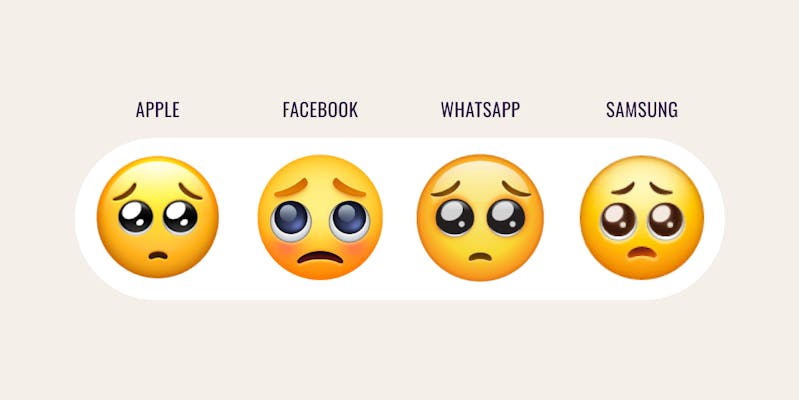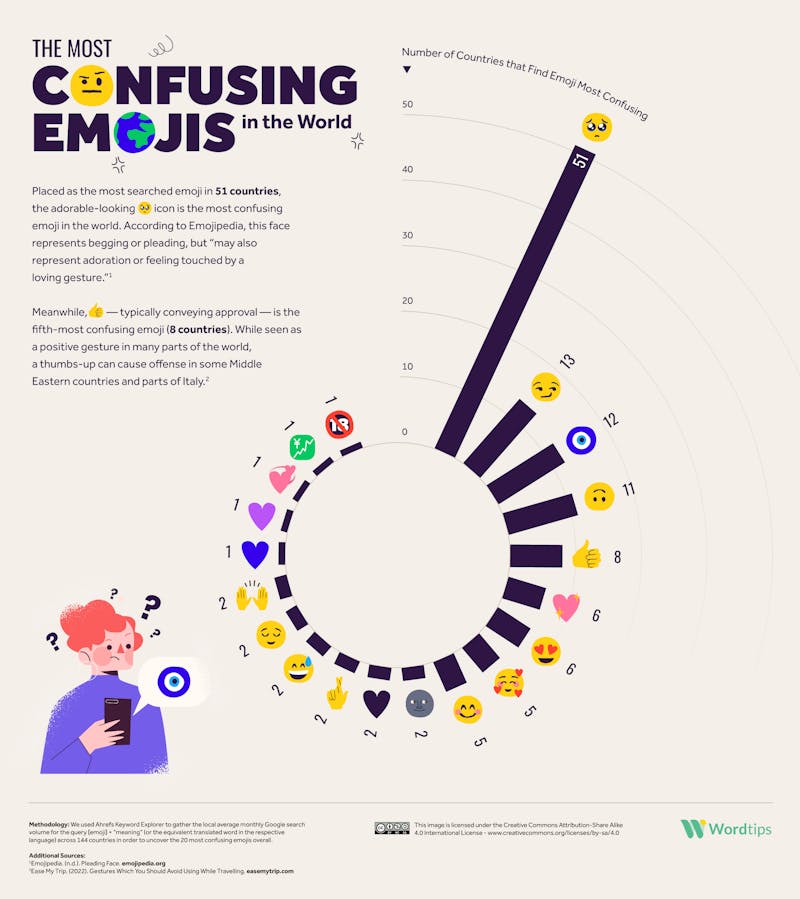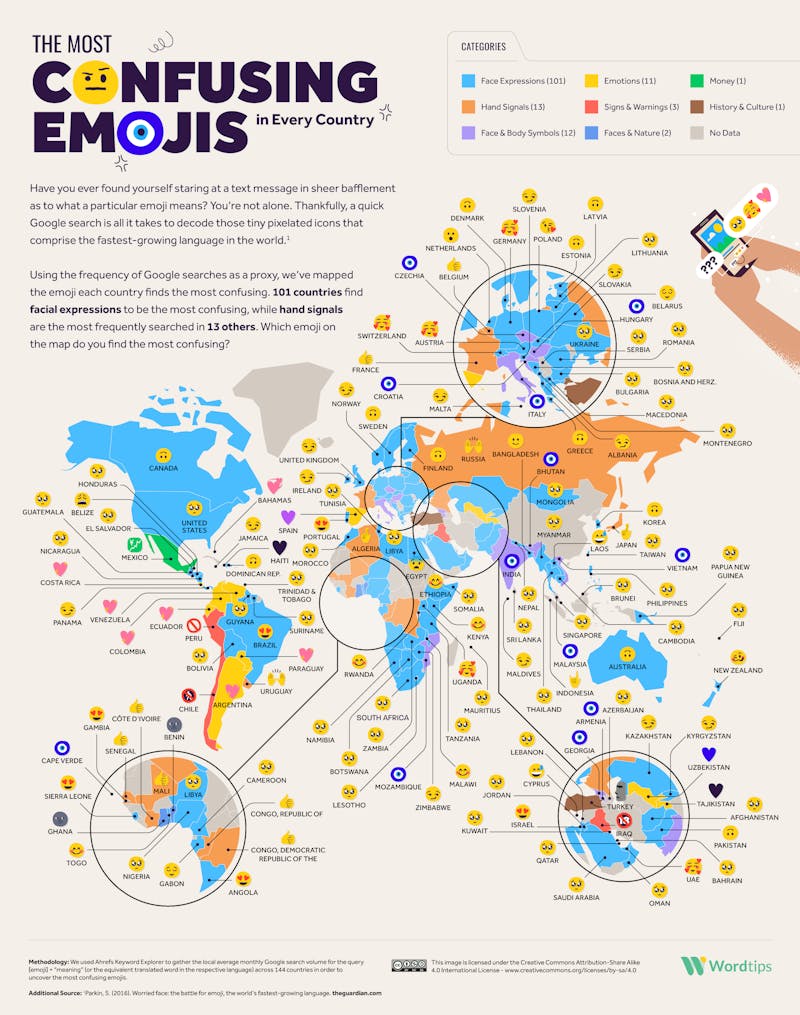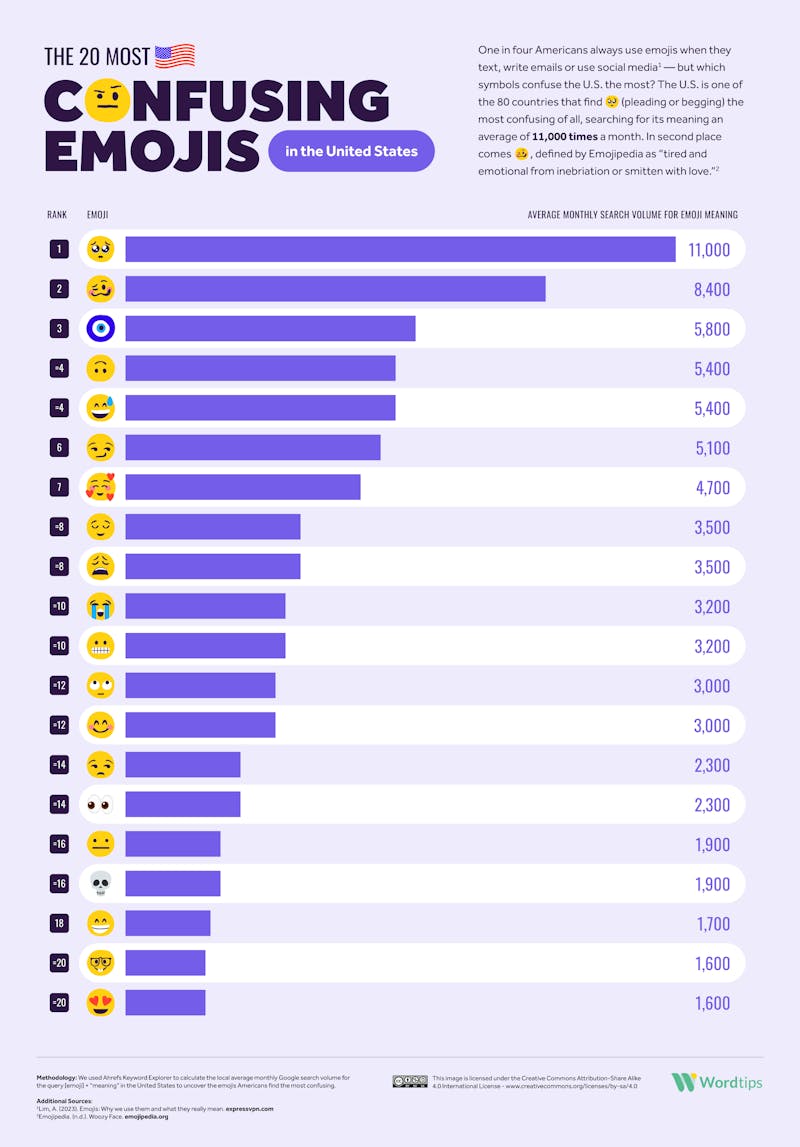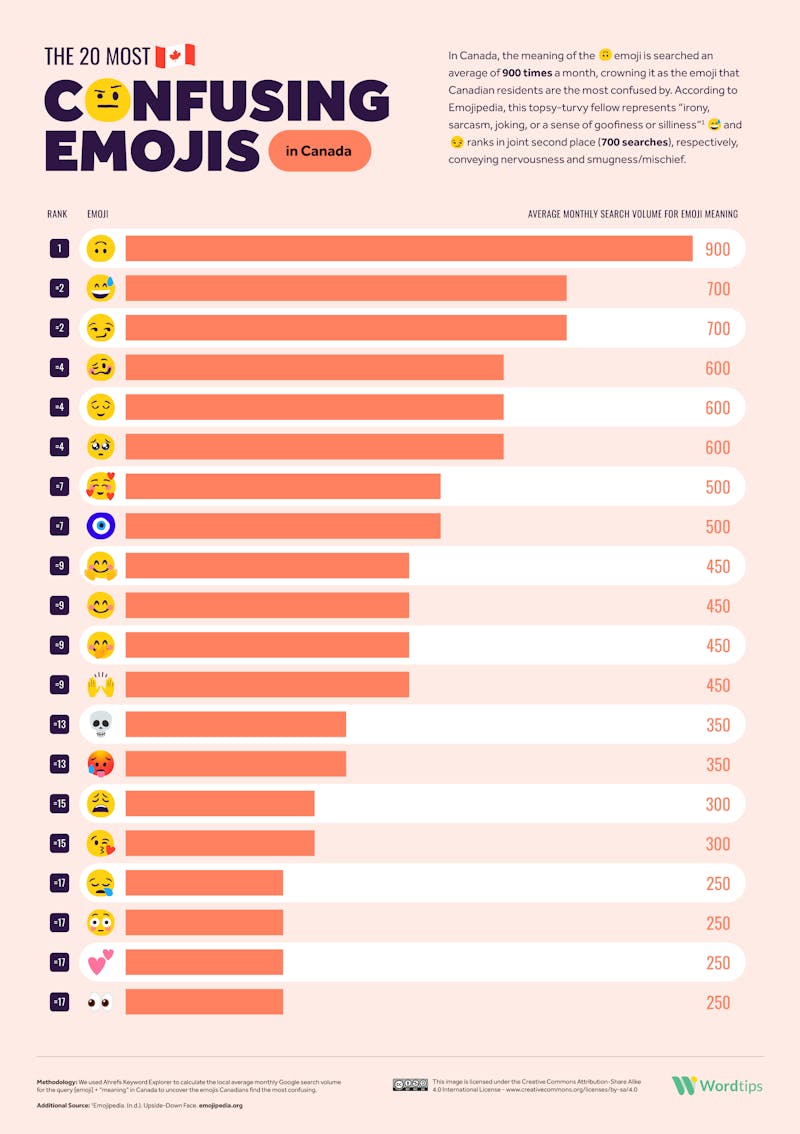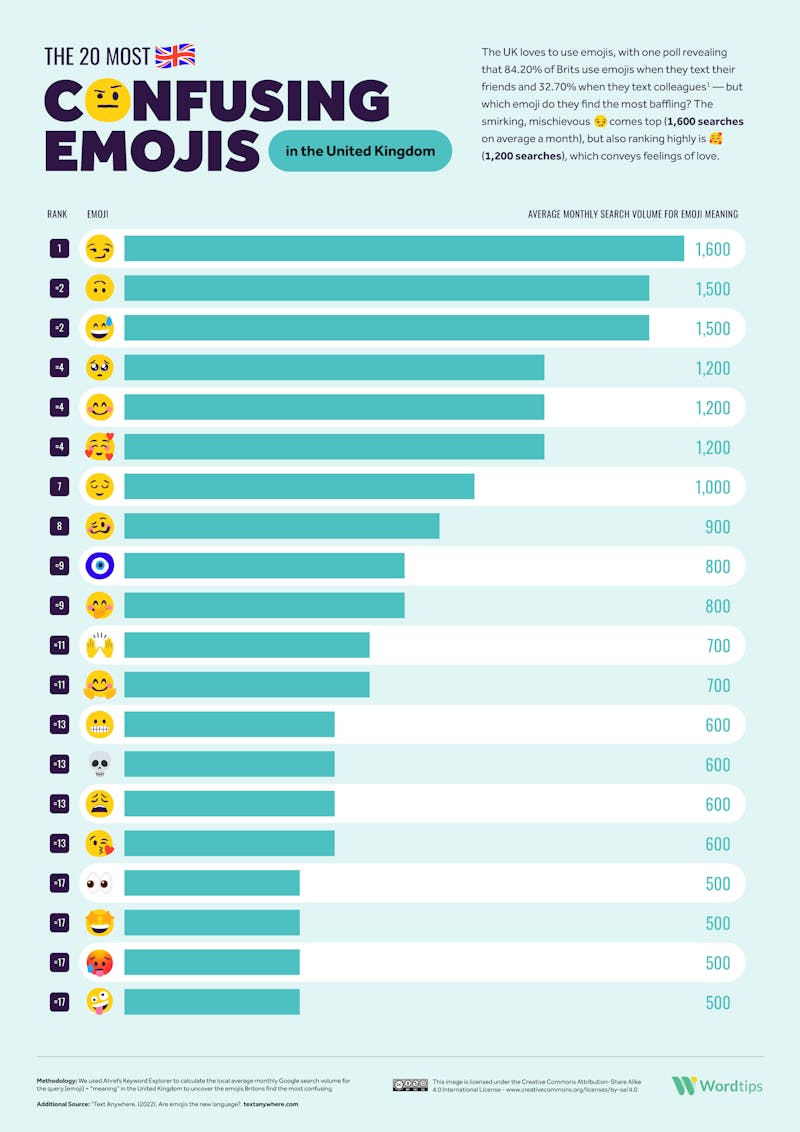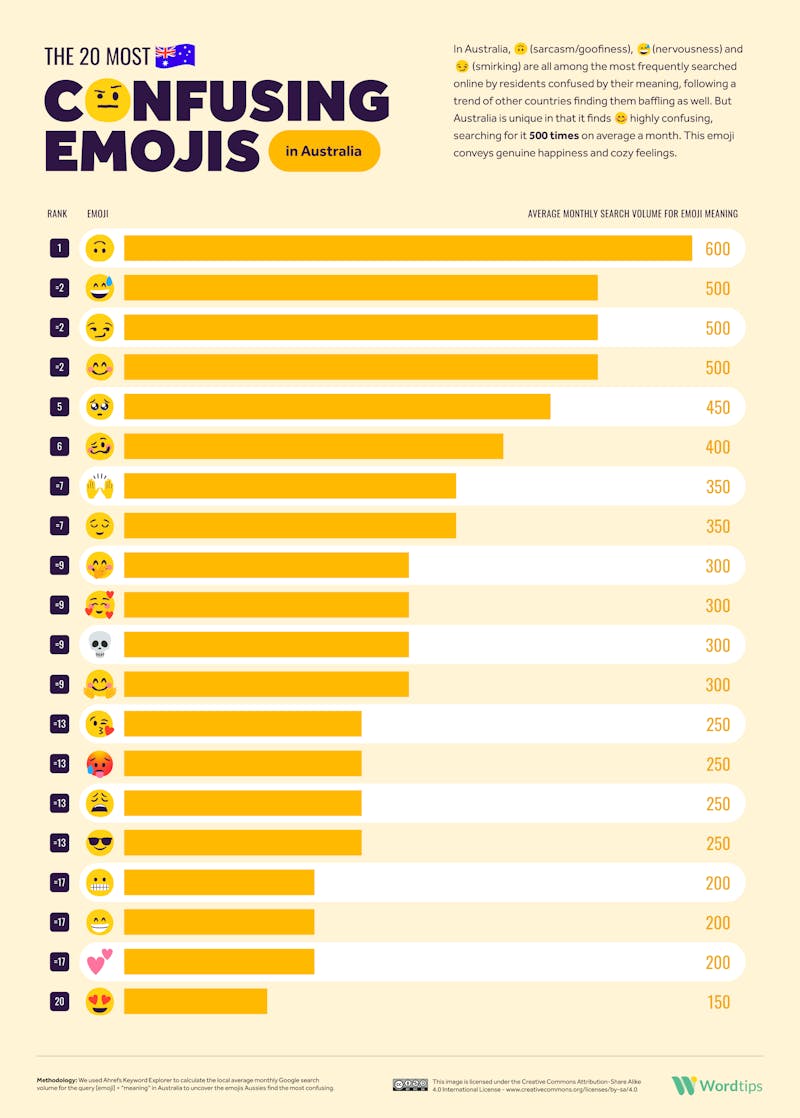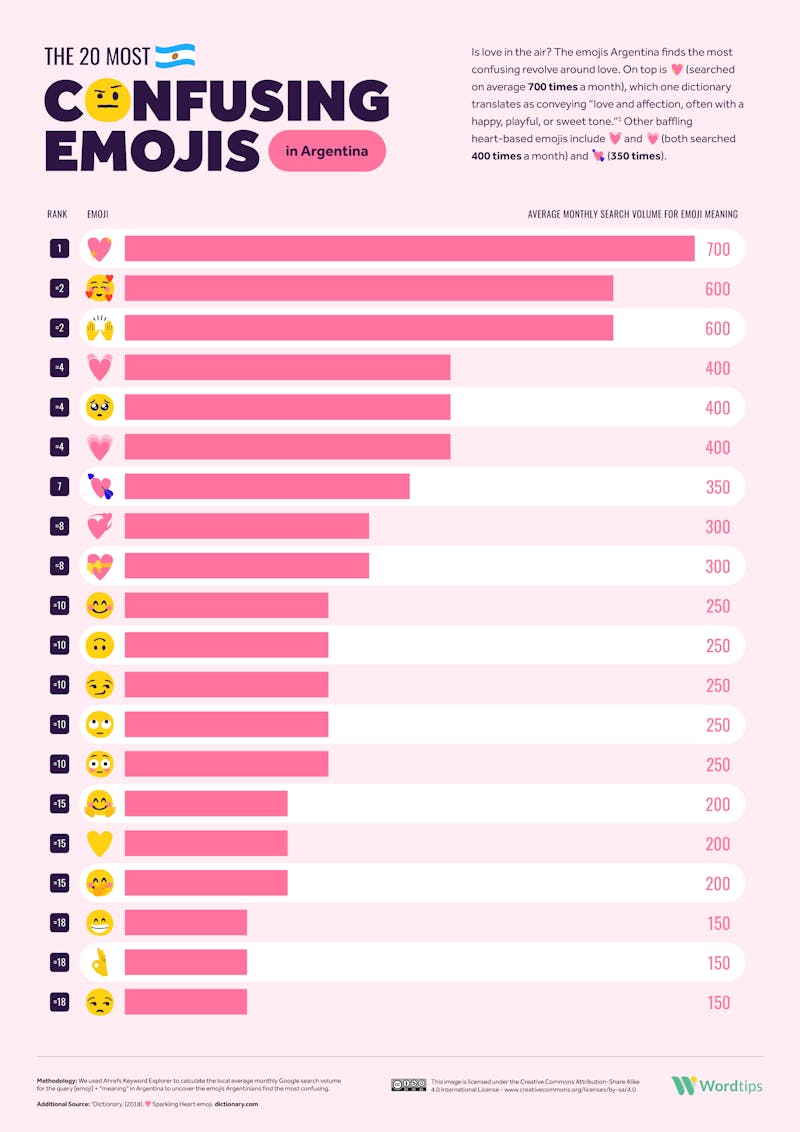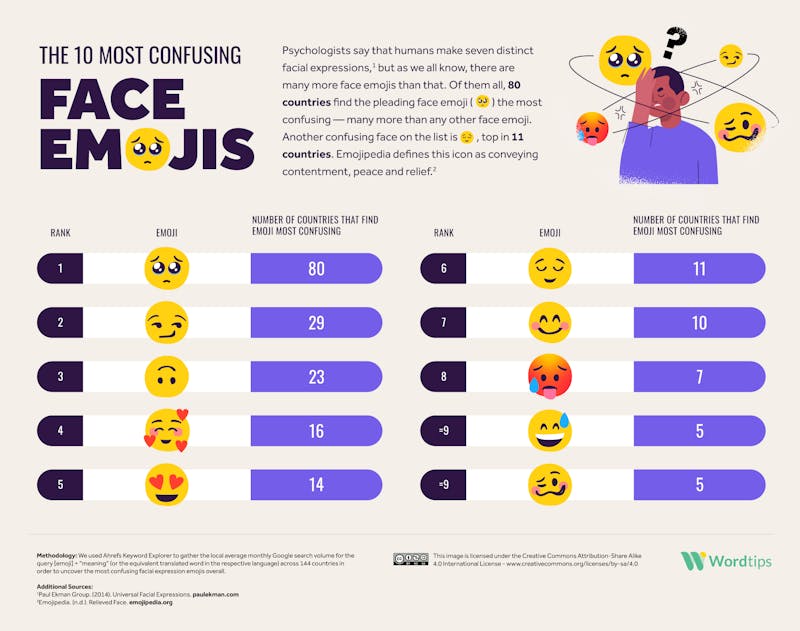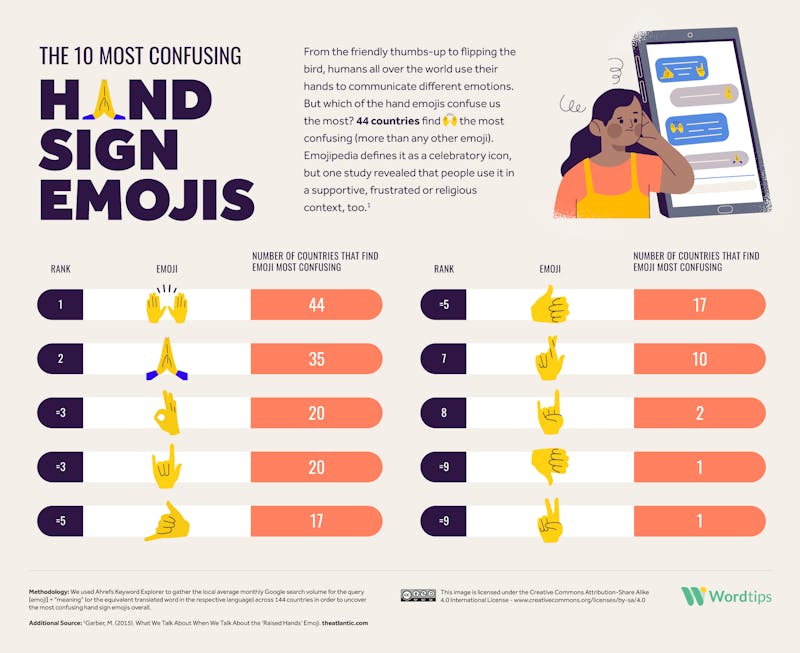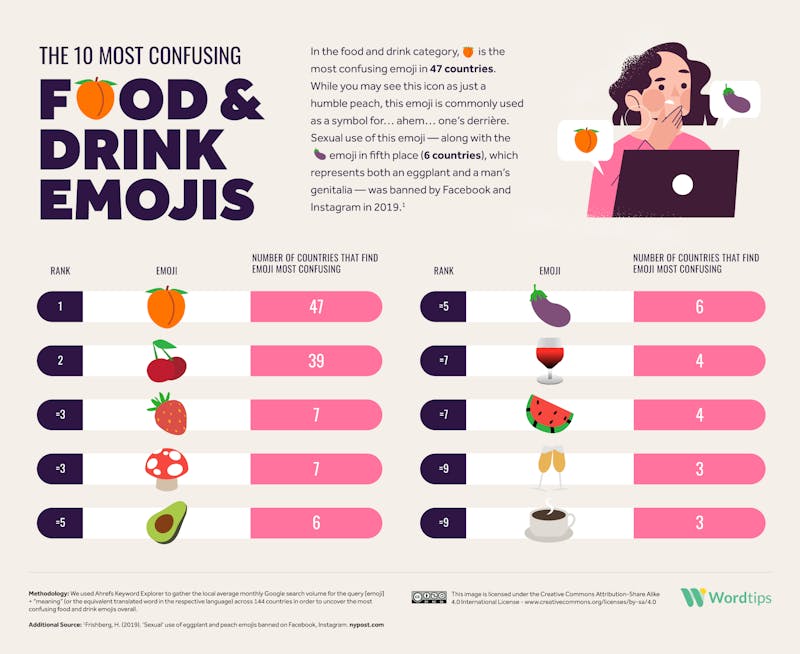The Most Confusing Emojis in Every Country
Last update: 3/22/2024

There are just 3,782 official emojis in the world, compared with around one million words in the English vocabulary. So, what’s stopping everyone from learning to speak emoji?
Well, if a picture is worth 1,000 words, then the emoji lexicon is effectively four million words strong. And when you consider the cultural baggage that each emoji acquires when it follows those undersea cables to computer screens in Japan, Wales or Côte d'Ivoire, it seems we’re hardly looking at the same emoji at all.
Of course, in many cases, we’re not looking at the same emoji. Every operating system has its own version of each emoji based on Unicode’s basic outline. For example, Samsung’s cookie emoji is more Wensleydale than chocolate chip — much to the disappointment of Cookie Monster (although presumably Wallace and Gromit find it “spot on”).
Deciphering an emoji strewn-message can sometimes be trickier than solving NYT’s latest Connections puzzle. Perhaps that’s why people worldwide make millions of searches every month to find the meaning of one emoji or another.
To help decrypt the most bewildering emojis, Word Tips has analyzed search data from around the world to find which emojis internet users find most confusing and has, thankfully, included the definitions for each.
About This Study
We compiled a list of 1,644 commonly used emojis and used the Ahrefs Keyword Explorer tool to calculate the average monthly search volume for each [emoji] + “meaning” in every country. We categorized the most searched emoji in each country to be that country’s most confusing emoji and identified the most confusing emojis globally, overall and by category.
Key Findings
- 🥺 (pleading face) is the most searched emoji meaning in 51 countries, including the U.S., making it the world’s most confusing emoji.
- 😏 (smirking face) is the UK’s most confusing emoji.
- 🙃 (upside-down face) is the most confusing emoji in Canada and Australia.
- 💖 (sparkling heart) is the most confusing emoji in Argentina.
The Most Confusing Emojis in the World
Three of the world’s four most confusing emojis are faces. The most confusing by a significant margin is 🥺 (pleading face), the most searched in 51 countries.
It doesn’t help that different systems incorporate different details, with Apple’s pleading face looking watery-eyed, Facebook’s blushing, and WhatsApp and Samsung bubbly eyes that appear to be hallucinating. Emojipedia describes 🥺 as a “yellow face with furrowed eyebrows, a small frown, and large, ‘puppy dog’ eyes, as if begging or pleading,” but this cuteness may also mean “adoration or feeling touched by a loving gesture.”
So why do we find face emojis so confusing? In part, frequent searches for their meaning correspond with their high frequency of use. For example, 🥺 jumped from 97th to 14th most used emoji in 2021, and six of the top ten emojis used last year were faces, as reflected in the high concentration of faces at the top of our chart of confusion.
But faces are confusing in general. “Mental representations are shaped by our past experiences and help us know what to expect when we are interpreting facial expressions,” notes social cognition Professor Rachael E. Jack, Ph.D., who conducted a study that showed people from different cultures receive expressions differently. “East Asians and Western Caucasians differ in terms of the features they think constitute an angry face or a happy face.”
🥺 (pleading face) is also the most confusing emoji in the U.S., where its meaning is searched 11,000 times every month. And it is the most confusing across much of Africa, the Balkans and the Middle East, as our map below illustrates.
Also among the world's top five most confusing emojis is 🧿 (Nazar Amulet), which is searched for 21,000 times per month in India alone. Meanwhile, 👍 (thumbs up) is the fifth-most confusing, topping the charts in eight countries — all of which have had French as the official language now or in the past. Although the French do use thumbs up to indicate approval or positivity, they also use it to indicate the number one.
The 20 Most Confusing Emojis in the United States
The most confusing emoji in the U.S. is 🥺 (pleading face), with 11,000 monthly searches (see The Most Confusing Emojis in the World, above). The second most confusing is 🥴 (woozy face), with 8,400 searches. The woozy face has been around since 2018 and features “a crumpled mouth and a cockeyed expression, as if tired and emotional from inebriation or smitten with love,” according to Emojipedia.
However, confusion still reigns over the proper meaning and use of 🥴. “Is it drunk? Hungover? Hangry? Horny? Confused about the country's current state of affairs?” asks Elle magazine, while The Rock responded to comparisons with his own cockeyed face by offering two alternative meanings: “I’m f*cking awesome” or “Excuse me, but I have gas.”
The 20 Most Confusing Emojis in Canada
Canada’s most confusing emoji is also the fourth most confusing in the world. 🙃 (upside-down face) is pretty confusing when taken at ‘face’ value — why is the face upside down? Why do we need that? But your mind may be blown when you consider it as a balding man with no mouth looking down at his shoes. Emojipedia tells us that 🙃 is commonly used “to convey irony, sarcasm, joking, or a sense of goofiness or silliness.”
The 🙃 which featured on the Microsoft Windows 10 Anniversary Update is a strange beast. Instead of a slight smile, the upside-down face has a toothy grin — which, inverted, looks like either gritted teeth or a small mental prison cell on the emoji’s forehead. Meanwhile, for Generation Z, the emoji has come to mean “this is terrible” or FML.
The 20 Most Confusing Emojis in the United Kingdom
It’s tight at the top in the UK: this shady consortium of characters 😏🙃😅🥺😊🥰 make up the top six most confusing emojis, and each of them gets between 1,200-1,600 searches per month.
However, 😏 (smirking face) is the most confusing of all. The Cambridge Dictionary notes that a smirk is “a smile that expresses satisfaction or pleasure about having done something or knowing something that is not known by someone else.” The smirking face emoji is “a sly, smug, mischievous, or suggestive facial expression. It features a half-smile, raised eyebrows and eyes looking to the side,” according to Emojipedia.
But what is the meaning of the smirking face? “Often used to convey flirtation or sexual innuendo,” suggests Emojipedia. Three UK notes that 😏 is “33% sarcasm, 33% sultriness and 33% silliness,” and the “perfect response for everything,” suggesting it can be “I don’t mind if I dooooo” or “I see what you did there,” or “Well well well!”… “or a million other things.”
The 20 Most Confusing Emojis in Australia
Australia shares its most confusing emoji, 🙃 (upside-down face), with Canada (see above). A trio of faces are tied in second place: 😅 (grinning face with sweat), 😏 (smirking face, see UK above) and 😊 (smiling face with smiling eyes). Eighteen of the twenty most confusing emojis are faces — if you count 💀 (skull) as a face.
Grinning face with sweat is “perfect for those times you think something will turn out OK, but you’re still a little nervous about it,” says Readers Digest Australia. “When to use it: When the forecast for the surprise birthday picnic you’re planning switches to “chance of rain” the day before.” Dating coach Max Alley says that 😅 features heavily in online dating, with men pairing it with suggestive emojis to indicate “that they’re being inappropriate, but also aware of the fact they’re being inappropriate.”
The 20 Most Confusing Emojis in Argentina
Argentina is an anomaly among the countries we’ve profiled: only eleven of its most confusing emojis are faces. Seven of the nine non-faces are heart variations, and even one of the faces features a heart (🥰, smiling face with hearts). While the heart icon is hardly anatomically correct, it is broadly understood across cultures — although perhaps it is the variations that people in Argentina find hard to fathom.
The most confusing of all is 💖 (sparkling heart). Emojipedia describes it as a “pink love heart with stars around it, making it look like it is sparkling or shimmering,” but doesn’t provide a definition. Dictionary.com suggests that 💖 “variously shows love and affection, often with a happy, playful, or sweet tone. While the glimmers of the sparkling heart emoji can suggest being head over heels, the emoji is also often used for feelings of peace on earth and goodwill towards all.”
One reason it might attract such curiosity in Argentina is that it was the emoji that Cristiano Ronaldo’s partner Georgina Rodriguez used when responding to Lionel Messi’s Laureus World Sportsman of the Year Award on Antonela Roccuzzo’s Instagram post.
The Most Confusing Emojis by Category
Next, we separated the most confusing emojis by category: people/faces, gestures/hands, and food and drink and re-counted the number of meaning searches in each country for each one. Then, we created rankings for each category according to the number of countries where each is found the most confusing in its category.
People and Face Emojis
🥺 (pleading face) is the most confusing emoji in 51 countries when all emojis are counted (see above) and in 80 countries when compared only with other people and face-themed emojis.
Also among the top face emojis is 😍 (smiling face with heart-eyes), which is searched 12,000 times monthly in Brazil. Emojipedia suggests it means “I love/am in love with this person or thing,” but people also use it to indicate “I like what I see” or “that’s beautiful.”
A little more ambiguous, 😌 (relieved face) is the most confusing face in 11 countries, despite not being among the ten most used emojis, like 😍. Previous Google and Microsoft versions of the relieved face were clearer, including beads of sweat to indicate that “phew!” moment.
Gestures and Hand Emojis
Does it mean “stay back,” “don’t shoot” or “check my nail varnish!”? 🙌 (raising hands) is the most confusing hand emoji in 44 countries, and its intended meaning is “celebrating success or another joyous event,” possibly as a “high ten.” It has also come to stand more specifically for “a job well done,” the hands and extended thumbs indicating a frame for the recipient’s work or certificate of achievement.
A 2015 study by Instagram found that the hashtags most commonly used with the 🙌 emoji are #waitonit, #justwaitonit, #wonthedoit, #nuffsaid, #yeslawd, #youtherealmvp, #stayblessed, #thatisall, thou, #enoughsaid, leggo, #onlythebeginning. “Which suggests, among other things, that 🙌 is simply an extreme form of all emoji,” writes Megan Garber in the Atlantic. “Their interpretation depends on… the alchemy that combines the lines of text, and the curves of images, into that most basic and complicated of things: meaning.”
Food and Drink Emojis
A fruit is rarely just a fruit. And fruit and veg (and fungus) make up seven of the world’s ten most confusing food and drink emojis. 🍑 (peach), 🍒 (cherries) and 🍆 (aubergine) are among them.
Or, in schoolkid (or online flirt) lexicon: 🍑 (buttocks — “Thanks to its distinctive cleft”), 🍒 (breasts/testicles/virginity), and 🍆 (phallus.) In fact, the “#🍆” was banned from Instagram search in 2015. Of course, since 🍆 is so misunderstood, folk could have just been searching for eggplant.
The 🍷 (wine glass) emoji might seem like an unambiguous depiction of red wine, but some versions have had a different shade or shape, which may have caused confusion. It has never been white, though: despite the efforts of the “white wine emoji movement,” neither a white nor rosé-filled wine glass has yet been approved.
“We live in an era where the rise of post-truth has left people demanding clear communication and the desire to represent their identity,” says disappointed white wine emoji campaigner Kendall-Jackson. “[F]ans of white wine feel they are not being represented.” So misunderstood!
I Wanna Know What 💖 Is
While the Oxford English Dictionary is updated with new words four times a year — sending crossword, Wordle and Scrabble fans on the hunt for new solutions — the Unicode consortium releases new emojis just once or twice annually.
But with new emojis for 2024 likely to include such subjective concepts as “splatter” and “root vegetable,” you can be sure plenty of confused internet users will be searching for new meanings and double entendres before you can memorize the shortcut for 😕 (confused face).
Methodology
We first curated a seed list of 1,644 commonly used emojis. We then used the Ahrefs Keyword Explorer tool to calculate the local average monthly search volume for the query [emoji] + “meaning” (or the equivalent translated word in the local language) in every country that returned search volume data.
This enabled us to discover:
- The most confusing emoji in each country (i.e., the emoji searched for the most);
- The top 20 most confusing emojis (ranked by the number of countries in which their meaning is searched the most frequently);
- The most confusing emoji in a particular category (ranked by the number of countries in which their meaning is searched the most frequently);
- The most confusing emojis in the United States, Canada, the UK, Australia and Argentina (ranked by how often they are searched for in those countries).
Our data is correct as of February 2024.
Additional Sources
Parkin, S. (2016). Worried face: the battle for emoji, the world's fastest-growing language. theguardian.com
Emojipedia. (n.d.). Pleading Face. emojipedia.org
Ease My Trip. (2022). Gestures Which You Should Avoid Using While Travelling. easemytrip.com
Paul Ekman Group. (2014). Universal Facial Expressions. paulekman.com
Emojipedia. (n.d.). Relieved Face. emojipedia.org
Garber, M. (2015). What We Talk About When We Talk About the 'Raised Hands' Emoji. theatlantic.com
Frishberg, H. (2019). ‘Sexual’ use of eggplant and peach emojis banned on Facebook, Instagram. nypost.com
Lim, A. (2023). Emojis: Why we use them and what they really mean. expressvpn.com
Emojipedia. (n.d.). Woozy Face. emojipedia.org
Emojipedia. (n.d.). Upside-Down Face. emojipedia.org
Text Anywhere. (2022). Are emojis the new language?. textanywhere.com
Dictionary. (2018). 💖 Sparkling Heart emoji. dictionary.com
